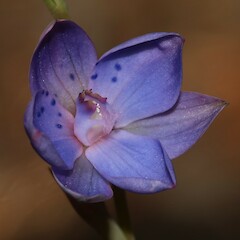Thelymitra ixioides
Common name
spotted sun orchid
Synonyms
Thelymitra ixioides var. typica Hatch, Thelymitra juncifolia Lindl., Thelymitra lilacina F.Muel. ex Lindl., Thelymitra iridioides Seib. ex Benth.
Family
Orchidaceae
Flora category
Vascular – Native
Endemic taxon
No
Endemic genus
No
Endemic family
No
Structural class
Orchids
NVS code
The National Vegetation Survey (NVS) Databank is a physical archive and electronic databank containing records of over 94,000 vegetation survey plots - including data from over 19,000 permanent plots. NVS maintains a standard set of species code abbreviations that correspond to standard scientific plant names from the Ngä Tipu o Aotearoa - New Zealand Plants database.
THEIXI
Chromosome number
2n = 28
Current conservation status
The conservation status of all known New Zealand vascular plant taxa at the rank of species and below were reassessed in 2017 using the New Zealand Threat Classification System (NZTCS) – more information about this can be found on the NZTCS website. This report includes a statistical summary and brief notes on changes since 2012 and replaces all previous NZTCS lists for vascular plants.
Please note, threat classifications are often suggested by authors when publications fall between NZTCS assessment periods – an interim threat classification status has not been assessed by the NZTCS panel.
- Conservation status of New Zealand indigenous vascular plants, 2017 . 2018. Peter J. de Lange, Jeremy R. Rolfe, John W. Barkla, Shannel P. Courtney, Paul D. Champion, Leon R. Perrie, Sarah M. Beadel, Kerry A. Ford, Ilse Breitwieser, Ines Schönberger, Rowan Hindmarsh-Walls, Peter B. Heenan and Kate Ladley. Department of Conservation. Source: NZTCS and licensed by DOC for reuse under the Creative Commons Attribution 4.0 International licence.
2017 | At Risk – Naturally Uncommon | Qualifiers: S?O, Sp
Previous conservation statuses
2012 | At Risk – Naturally Uncommon | Qualifiers: Sp
2009 | Not Threatened
2004 | Not Threatened
Distribution
Indigenous. New Zealand: North Island, South Island. Also Australia.
Habitat
Coastal to montane (up to 900 m a.s.l.). In open ground, especially clay pans within gumland scrub but also colonising roadside banks, road gravel, stable dune slacks, and well-lit but sparsely vegetated ground under taller scrub and forest. Sometimes in beech (Nothofagaceae) forest or on the margins of montane streams. Rarely in peat bogs.
Wetland plant indicator status rating
Information derived from the revised national wetland plant list prepared to assist councils in delineating and monitoring wetlands (Clarkson et al., 2021 Manaaki Whenua – Landcare Research Contract Report LC3975 for Hawke’s Bay Regional Council). The national plant list categorises plants by the extent to which they are found in wetlands and not ‘drylands’. The indicator status ratings are OBL (obligate wetland), FACW (facultative wetland), FAC (facultative), FACU (facultative upland), and UPL (obligate upland). If you have suggestions for the Wetland Indicator Status Rating, please contact: [Enable JavaScript to view protected content]
FAC: Facultative
Commonly occurs as either a hydrophyte or non-hydrophyte (non-wetlands).
Detailed description
Terrestrial, tuberous, glabrous, spring to summer-green perennial herb, either solitary or in small colonies of 2–4 plants. Plant at flower up to 700 mm tall. Leaf solitary, fleshy, deeply channelled and more or less longitudinally ribbed, 50–120 mm long, reddish-green to almost silvery reddish-green near base otherwise yellow-green to dark green, linear-lanceolate, base closely sheathing, undersides finely rugose. Flowering stem stiffly erect, wiry, reddish green to silvery-green. Bracts 1–2–(3), foliaceous, closely-sheathing, fleshy, bases dark reddish-green to silvery reddish-green otherwise green to yellow-green. Raceme bearing (1)–5–(20) flowers (usually much fewer). Flowers 11–18 mm diameter, blue, segments widely spreading, dorsal sepal and petals with darker blue or purple spots. Sepals and petals very broad. Labellum distinctly rounded. Column up to 5 mm long, erect, bluish grading to dark purple near apex; column arms flattened, cilia white, largely marginal, column arms projecting from anterior margin of the side lobule, cilia white or mauve; post anther lobe slightly taller than anther, erect, not cucullate, the back and apex bearing numerous violet or yellow finger-like calli (the tallest yellow or orange); side lobules distinct, usually taller, yellow, margins mostly laciniate.
Manaaki Whenua Online Interactive Key
Similar taxa
The reddish-green to silvery reddish-green, deeply ribbed leaves with finely rugose undersides, and distinctive blue flowers with darker blue or purple spots on the dorsal sepal and petals, and the non hooded, post anther lobe bearing conspicuous yellow or orange finger like calli immediately separate this species from any other Thelymitra in New Zealand. New Zealand plants are self pollinating and Australian plants insect-pollinated.
Flowering
September–December
Flower colours
Blue, Violet/Purple
Fruiting
November–March
Propagation technique
Difficult—should not be removed from the wild.
Threats
No apparent threats but not common. This species rarely occurs in any abundance at any particular site and is very vulnerable to roadworks, animal browse, loss through succession to taller forest and because it has attractive flowers that make it a target of plant collectors.
Etymology
thelymitra: Woman’s hat
ixioides: Like an ixia
Where To Buy
Not commercially available
Notes on taxonomy
New Zealand plants differ from those in Australian (from where it was first described by their autogamous rather than entomophilous reproductive biology). For this reason New Zealand plants are usually regarded as an unnamed entity allied to T. ixioides. Research into the taxonomic status of the New Zealand plant is in progress.
Attribution
Description adapted from Moore and Edgar (1970).
References and further reading
Moore LB, Edgar E. 1970. Flora of New Zealand, Volume II. Indigenous Tracheophyta: Monocotyledones except Gramineae. Government Printer, Wellington, NZ. 354 p.
Rolfe JR, de Lange PJ. 2010. Illustrated guide to New Zealand sun orchids, Thelymitra (Orchidaceae). Jeremy Rolfe, Wellington, NZ. 57 p.








